At 85 pages, the Living Sober PDF has provided practical advice and tips on thriving in sobriety that has helped countless people who are navigating the early days of recovery. Written by Alcoholics Anonymous member Barry Leach, the booklet is said to have come into fruition with the help of inputs from AA members who have had continuous sobriety.

And it is not for nothing that they have shared some methods on how to find new ways to live without alcohol. In fact, this little book of simple and practical advice has helped loads of people who need to get through the day, through social occasions, or events without taking their first drink.
However, unlike the 85-pager Living Sober PDF, this summary highlights the booklet’s greatest and most useful suggestions in fewer pages. After all, day-to-day trigger situations call for a go-to companion that those in recovery can consult while surviving another day away from a drink.
This article is going to be updated frequently until it features all 32 chapters featured in the Living Sober PDF. Please check back for updates.
The Living Sober Chapter 1 starts with a disclaimer that its contents are not intended to offer a treatment plan for recovery from alcohol abuse. But while it does not serve as a replacement for the Big Book and Twelve and Twelve, it is a great supplement to the two rather traditional books.
Drinking alcohol is influenced by daily habits, namely thinking habits and doing habits. Thinking habits are emotions and feelings felt inside by an individual while doing habits are behavioral patterns that have led to alcohol abuse.
Living Sober PDF recommends identifying these destructive habits and addressing them by replacing them with new, more positive habits to cope with the urge to binge drink. It is worth noting, however, that the journey to recovery has no shortcuts and it may take some time before healthier coping strategies become habitual practice.
The chapter also indicates that the booklet is meant to be a handy manual that is supposed to be consulted every once in a while when someone needs a little push to decline alcohol at home or at work.
People whose goal is to stay on the road to recovery may benefit from most, if not all, the suggestions discussed in Living Sober. The ideas presented can also be followed in no particular order or arranged differently in a way that best works for the afflicted person.
“The alcoholic can learn to completely control his disease, but the
affliction cannot be cured so that he can return to alcohol without
adverse consequences.“

To get the most out of the Living Sober PDF, the author cited two cautions that have been proven to be helpful: keep an open mind and use one’s common sense. Keeping an open mind simply means not completely dismissing unappealing ideas, but setting them aside for later use.
For instance, one of the most common myths about Alcoholics Anonymous is that it is a religious society. And while it is one of the key elements of the group’s approach to recovery, there is room in the organization for believers and nonbelievers alike.
Therefore, some people may keep religious ideas at bay for the time being, but they are always welcome to have a change of heart on these ideas at a later time. On the other hand, utilizing one’s common sense means making intelligent use of the ideas presented in the text.
This is critical in accurately applying the suggestions from the booklet in real life. Leach used the example of the candy-eating idea, which is obviously not recommended for recovering alcoholics who are also diabetics.
A.A. also added that they do not offer medical or scientific advice on staying sober. Therefore, anyone who has developed serious health problems should seek medical attention first before reading the booklet.
Those who are not seriously ill, however, can benefit from the advice of individuals who have once been in their position. After all, the booklet is founded on personal experiences on how to live sober. The group indicates that sobriety is the stepping stone to recovery — which can be handled better through the guidance of the booklet.
The second chapter emphasizes the importance of self-control by internalizing one of the most commonly used expressions in Alcoholics Anonymous: “If you don’t take that first drink, you can’t get drunk.”
Staying away involves a strong will to avoid only one drink, which is the first one. The chapter focuses on this simple concept, as simply not taking the first drink keeps a person away from the trap of drinking just one drink, only to end up taking many other drinks after the first one.
This temptation tends to keep the vicious cycle of alcohol abuse going. To escape this habit, the text suggests simply not picking up the first drink. It adds that according to experts, the first drink triggers the irresistible urge to consume increasingly greater amounts of alcohol until an individual is back to square one – drinking more than intended.
“If you don’t take that first drink, you can’t get drunk.”
The 24-hour plan involves the wise use of 24 hours in a day and avoids making and breaking long-term promises. This section of the booklet talks about living in the now and suggests taking advantage of one’s daily life to become gradually sober.
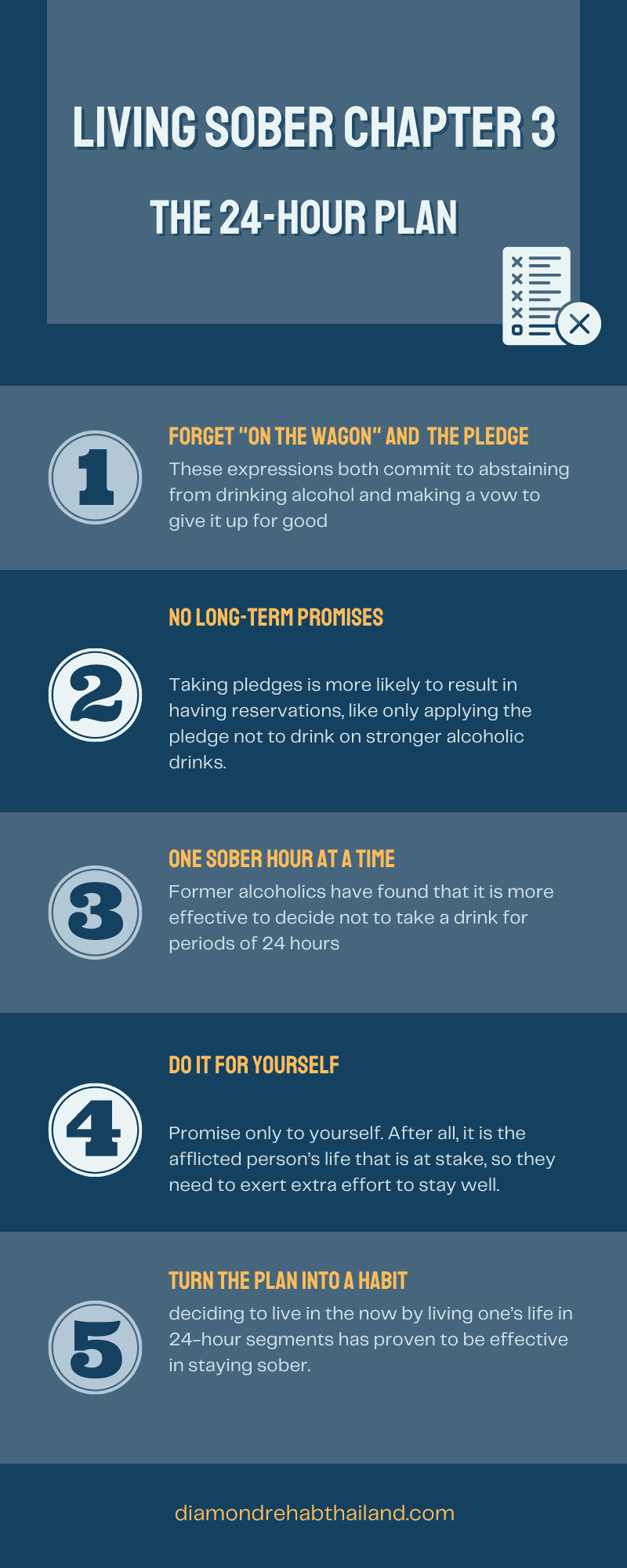
In A.A. the use of the expressions “on the wagon” and “taking the pledge” are avoided as much as possible. These expressions both commit to abstaining from drinking alcohol and making a vow to give it up for good.
Long-term promises, however, as several A.A. members found, are not as good as they seem. Taking pledges is more likely to result in having reservations, like only applying the pledge not to drink stronger alcoholic drinks.
The result? These individuals also get drunk on beer or wine as they do on the hard stuff. But even though this is not news to them, they still do it. Others have been successful in temporarily keeping alcoholic drinks at bay. However, when the time was up, the drinking spree went back. Only this time, it is mixed with worse feelings of guilt and remorse.
“Long-term promises are not as good as they seem”
Because the taboo expressions remind former alcoholics of their failures, they have learned better as they found that it is more realistic to decide not to take a drink just for 24 hours.
The promise, however, of not taking a drink just for the day, is not made to family members or fellow A.A. members, but only to oneself. After all, it is the afflicted person’s life that is at stake, so they need to exert extra effort to stay well.
The 24-hour plan is also very flexible in that it can be divided into smaller parts if the urge to drink becomes too irresistible. For instance, as the booklet suggests, deciding not to drink can begin with only one hour. A recovering alcoholic can brave an hour of cravings, then an hour more, and the rest will follow.
In fact, many recovery stories have begun with one sober hour. Additionally, the 24-hour plan can be done anytime and anywhere. Whether one is at home or at work, in the afternoon or in the middle of the night, a decision can be made to not drink in the next few minutes or the next coming hours.
Once the plan becomes a habit, the cycle of planning and coming to an end with the expressions “going on the wagon” and “taking a pledge” will be no more. Instead, deciding to live in the now by living one’s life in 24-hour segments has proven to be effective in staying sober.
This section of the booklet talks about living in the now and suggests taking advantage of one’s daily life to become gradually sober. The 24-hour plan involves the wise use of 24 hours in a day and avoids making and breaking long-term promises.

Some readers may not like or agree with the position that the title of the chapter is arguing. Especially today, when several treatment facilities, with the use of evidence-based approaches, have successfully guided people with alcohol use disorders on the road to recovery.
However, as the author suggested in the second chapter, it is best to keep an open mind when reading the booklet. In the same section, it was also made clear that A.A. does not offer medical or scientific advice, but is solely based on the members’ personal experience.
The chapter suggests developing better thought patterns that can help an afflicted individual gain a new perspective on their situation. Instead of feeling like they are missing a whole lot in life because they could not drink alcohol, according to the booklet, people should learn to accept their bodily limitations to maintain good health while in recovery.
A.A. is also convinced that alcohol use disorder is incurable. However, the author goes on to explain that the condition cannot be cured in the sense that people can no longer change their body chemistry and go back to being their pre-alcoholic self anymore.
Leach expounded further on this idea by giving an analogy of a pickle that could no longer go back into its cucumber form. The group also believes that alcoholism is a fatal disease, citing their experiences as witnesses to alcoholics drinking themselves to death or dying while going through withdrawal symptoms. The booklet also made mention of accidents or fatal events, which, despite not being directly associated with drinking, could actually happen because of it. These include car accidents, fire, heart attack, and even suicide.
The fifth chapter of Living Sober PDF talks about how giving other people power over you can negatively influence your drinking habits. Centered on the idiom “Live and let live,” the section shows how A.A.’s have used the saying to their own advantage and to aid their own recovery.
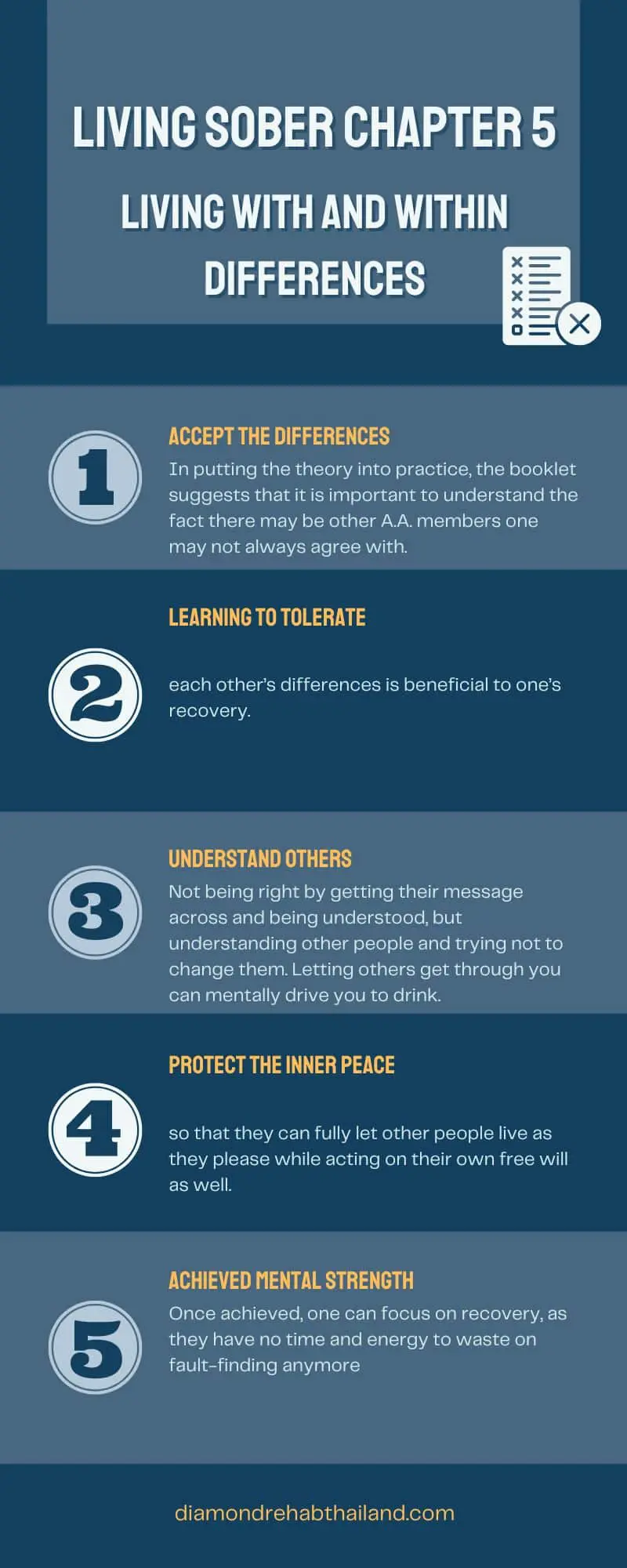
It is impossible to please everyone, no matter how hard someone tries. This remark has been so commonly expressed by other people that we often ignore how important it is to remind ourselves of this simple saying from time to time.
In fact, this reminder delivered benefits to many recovering alcoholics. When A.A.’s look back at their history of drinking, they notice that their drinking problems were almost always related to other people. From experimenting with alcoholic drinks during teenage years to keeping their drinking habits a secret from loved ones and becoming extra defensive when others mention their alcohol consumption, every circumstance involves other people.
However, as cited from the author’s own experience when he joined the group, it was a relief to meet a different breed of people in A.A. People who did not look with disdain and showed no hostility toward them, but welcomed them with understanding and concern, instead.
But it is also perfectly natural to meet some people within or outside the circle who will not be as welcoming or understanding as others. After all, some individuals are more skeptical and may easily hold themselves back from trusting recovered alcoholics who once spiraled into social and moral decline. But that’s perfectly fine. Living Sober PDF says here’s why:
This chapter of Living Sober PDF focuses on building better coping skills through purposeful activities. As with any other forms of addiction, coping strategies are an important predictor of an individual’s recovery from alcoholism.
It is no easy feat, though, as drinking used to be a habit that was very hard to break for A.A. members. But once that habit was gone, what they had was lots of free time. At first, they were clueless on how to spend it without drinking-related activities, but they found that it was better to distract themselves with new tasks or activities instead of becoming preoccupied with thoughts of staying away from alcohol.
Simply stopping drinking is never enough, and this is an understanding A.A.’s gained through their experiences. And on the topic of experiences, the sixth chapter also gives readers a glimpse of what happens in an A.A. meeting and what people can expect during the gathering. People in recovery need new hobbies or activities to get busy with so they can overcome negative thought patterns and curb cravings. The booklet states that people may benefit from two kinds of activities that have been proven effective as an aid to their sobriety.
Activity in and around A.A.
Recovering from alcoholism is no walk in the park. The first early days of recovery can especially feel like there is not much progress taking place. A.A. members are no strangers to this, as well. During their drinking days, their minds would be so wired that they could easily think of endless excuses to rationalize their drinking behaviors.
However, during the early stages of recovery, their minds would often go blank and they would struggle to think of any sober activities to do. As Leach puts it, this might be a result of recently just being out of the habit or maybe the mind needs more time to adjust after the absence of alcohol in the system.
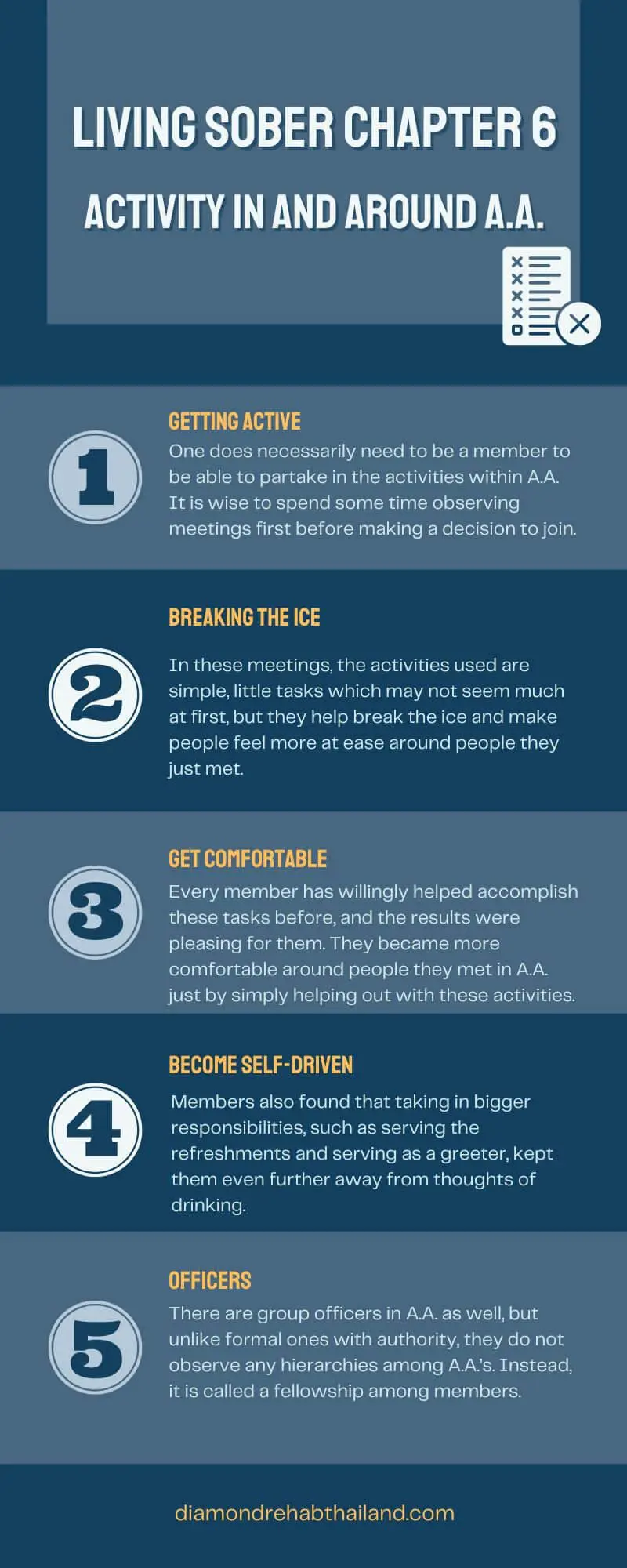
This section gives a list of social activities that do not involve alcohol. Coming from A.A. members themselves, these activities are especially helpful during early recovery, when the afflicted person still has difficulty thinking of things to do instead of drinking.
The last part of the text reminds people not to get ahead of themselves. The thought of engaging in these activities may be exciting, but try to do them one at a time. After all, recovery is a lifelong process that takes time and requires dedication to get through each step.
“God, grant me the serenity to accept the things I cannot change, courage to change the things I can, and wisdom to know the difference.”
This slightly altered version of the Serenity Prayer has been adopted by Alcoholics Anonymous and can be seen posted in the group’s meeting rooms. And as initially stated in the first part of Living Sober PDF, there is no religious requirement for an A.A. membership.
However, people of different beliefs and non-beliefs have benefited from the Serenity Prayer when they saw it as useful guidance in staying sober. For instance, A.A. members have put alcoholism on the top of the list of the things they cannot change.
This is in recognition of sobriety as a lifelong process and having the knowledge that turning into a nonalcoholic does not happen overnight. Coupled with this knowledge, however, is not letting go of one’s control over their situation. They know that they cannot change their situation, but they can change their attitude about it.
This is possible when one works hard to have the courage and wisdom to transform from drunk alcoholics into sober alcoholics. The author shared how the word serenity seemed overwhelming when they first encountered the prayer. However, when they acknowledged that for people like them, serenity means maintaining a realistic view of the world while protecting their inner peace and strength, nothing could stop them from aiming for that state of mind.
As people who have put in the work to successfully get through the road to recovery, A.A. members know too well how important it is to avoid triggers of relapse. From times to places, old activities and even people, what could seem as small risks could sneak up on a person and distract them from staying sober.
But in this section of the booklet, A.A.’s have shared some of the little changes one needs to make to avoid slipping back into old, drinking-related habits. For instance, starting the day with a coffee or tea instead of an alcoholic drink. A short exercise, alone time, or a morning meditation may also help with starting a new day.
Changing one’s route on the way to work to avoid triggers that may make them want to drink again is also beneficial for people in recovery. Taking note of one’s prime drinking times also helps with replacing the old routine with a new, healthier activity. For homemakers, rearranging daily chores was effective in changing routines, while for working people, really having coffee or tea during coffee break instead of an alcoholic drink worked best.
The author also added that it is good to have a companion who shares the same experiences during this shift in routines. Furthermore, instead of heading to your frequented restaurant where the staff is familiar with what you are having, you can opt for a new place and have new buddies to enjoy lunchtime with. Leach also emphasized the importance of making practical, easier changes in habits over testing one’s willpower when it comes to matters involving health.
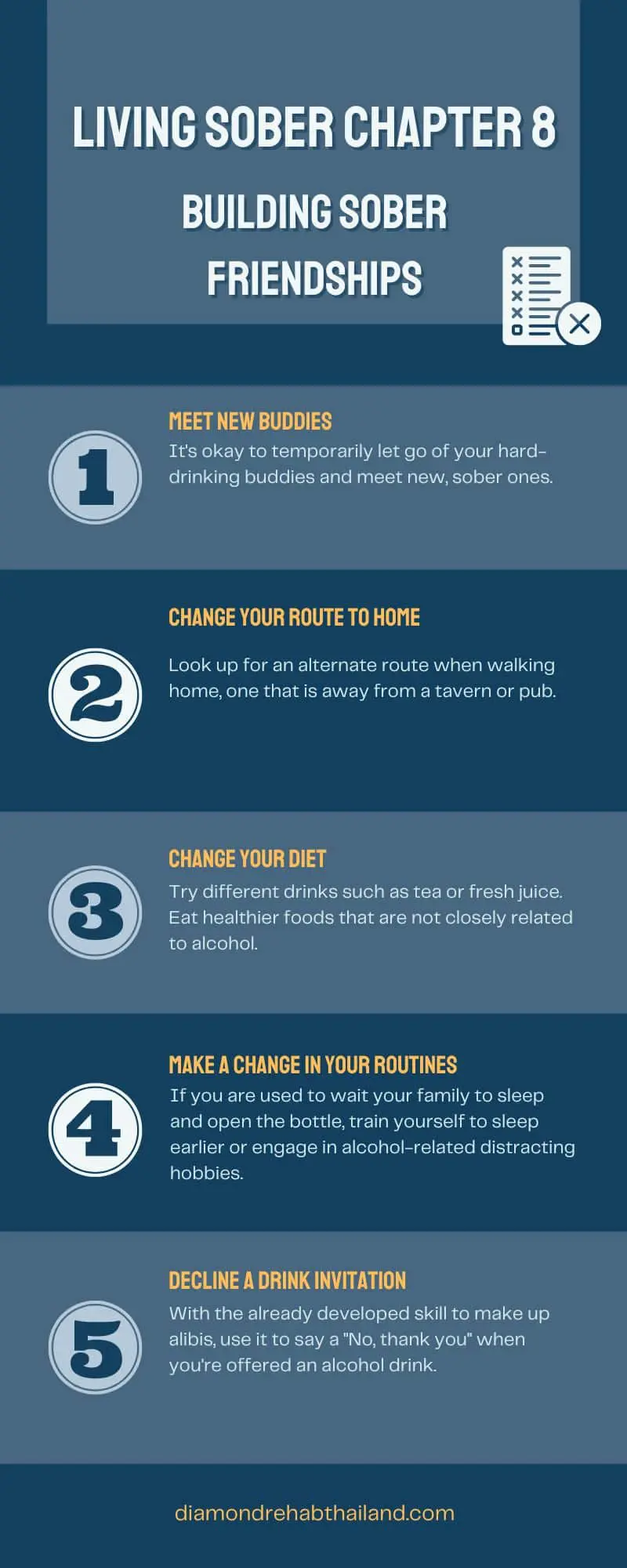
On getting rid of any alcohol drinks in the house, A.A. members have varying opinions. While some believe that avoiding alcoholic beverages forever is impossible while living in a drinking society, and therefore have kept the bottles of liquor at home and serve it only for guests, others maintain having no alcohol within the premises until their sobriety is in a steady state is much better. Those who have the latter stance lean more on being safe than sorry.
At the end of the day, however, you know yourself better, and you get to choose your own theory. You know your drinking behaviors and the factors that may influence it. The tips mentioned in the eighth chapter of Living Sober PDF may appear simple to some people, but they have provided A.A. members with a much-needed push in early recovery.
As already clarified in the early chapters, the booklet contains advice taken from the A.A. members’ personal experiences, and not from scientific reports. This is why the section does not explain how eating or drinking sweets curb alcohol cravings, at least in medical or technical terms.
What the members have, however, is anecdotal evidence that even for those who are not fans of sweets, the trick managed to work. But members of the group are also aware that consumption of sweets whenever the urge to drink arises does not apply to everyone. After all, others have health conditions in which sugar should be avoided. In such cases, fruits and other healthy alternatives to sweet food and drink may be consumed instead.
For some, it is not just the sweet taste that helps damp down the urge to drink. It may also be due to new habits that one can form instead of grabbing a glass of liquor. For instance, having a glass of fruit juice or soft drink, chewing, and swallowing are simple yet effective substitute actions for downing bottles of liquor.
Checking with a physician has also helped A.A. members realize that they are more undernourished than they know. As such, for others, any good food that can fill their stomach, from hamburgers to cheese and nuts, also does the trick.
And while others worry that replacing drinking habits with eating habits can make them gain unnecessary weight, members have seen that this is rarely the case. In fact, many of them lost weight when they replaced alcohol with wholesome food, while others have healthfully added some pounds to their weight.
Moreover, a little weight gain seems to be a small sacrifice compared with the possible consequences of alcoholism. But if one’s weight situation continues to be a cause for concern, A.A. recommends talking to a medical professional who has an expertise in weight problems and one who can also treat and advocate for alcohol addicted patients.
On the early days of achieving sobriety, unintended drinking sessions can happen. A.A. members have learned that just postponing the first drink and having something else in its place gives them the opportunity to remind themselves about their struggles by far. But they also know that they have another option when confronted with triggers and stressful times — make use of the ‘telephone therapy.’
In A.A., members are encouraged to get each other’s telephone numbers and exchange phone calls whenever the urge to drink arises.
The thought of talking to a stranger over the phone may appear strange at first, but the experience turned out to be overwhelmingly positive for many A.A. members. Every person on the other end of the line has been welcoming and empathetic, as they understood their fellow members’ struggles even without explaining the reason behind the call.
They automatically understand, and the time of the call, nor the reason for it, did not matter to them, either. A.A.’s can also call each other in the face of fear, anxiety, or panic. When they communicated about their real feelings and what they attempted to do about these negative emotions, no judgment was made. As someone who has been in the same situation, the person who was telephoned was always ready to understand.
And with a little practical advice, helpful information, or tough tips, the thought of a drink easily disappeared for them. In fact, usual activities can also be done with fellow A.A. members, such as eating together, listening to music, chatting, or even camping. Although these social activities are also possible with other friends who are not recovered alcoholics, the bond you form with people who have the same goal of achieving sobriety as you do is something that is special and unique.
The majority of A.A. members make their first telephone calls to those who are newly sober, just like them. But one does not have to become a member first to try how telephone therapy works. In fact, anyone can reach A.A. on their telephone number, which can be found on many telephone directories, and even on their website.
Anyone can dial the group’s number and be able to talk to someone who genuinely understands. After all, for many who have tried telephone therapy, reaching for the phone instead of a drink easily does the trick.
Anyone who has tried to read or research things about Alcoholics Anonymous has surely encountered the word “sponsor.”
A sponsor is a recovered alcoholic who has been sober for a longer time. New A.A. members are encouraged to get a sponsor and it is up to them to pick their potential sponsor. The major importance of having one is that a newcomer gets to have a friendly guide while they navigate their own way through A.A.
This chapter of Living Sober PDF details some tips about sponsorships given by sober A.A. members, taken from their many years of experience in the organization. Those who have remained sober believe that the following suggestions may help in knowing what to expect from a sponsor:
Heavy drinkers often tend to ignore their tiredness due to the initial stimulant effects of alcohol. And although drinking to excess may cause someone to fall asleep faster, their sleep is often of poor quality and they experience sleep disruptions toward the end of the night.
Sleep problems are very common in recovering alcoholics and it can also cause relapse in many people. This is why the 12th chapter of Living Sober PDF suggests something to combat this: Get plenty of rest.
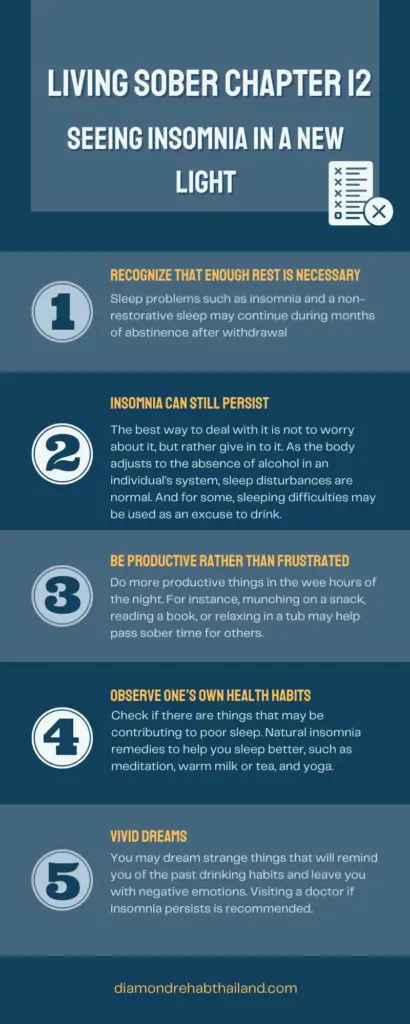
If the fight club is known for its first rule (which we are not going to talk about), Alcoholics Anonymous has something of that sort, too.
A.A. members swear by the saying ‘first things first,’ which simply means not taking a drink no matter what time, place, circumstance, or inconvenience is involved.
The organization asserts that above all, members should prioritize staying away from the drink. But this does not mean putting sobriety at the top of the priority list ahead of family, work, or friends. Instead, A.A. members view alcoholism as a life-or-death situation that should be avoided to make themselves available for their family, friends, and job. After all, being able to save their lives from the condition allows them to cherish the most important things in life.
The old saying also helped remind members of what should be given priority during the early days of recovery. As former alcoholics, they would often overthink about how to catch up on all the important activities they have missed during their drinking days.
But this is where ‘first things first’ comes in handy. Because when sobriety is put first above all, everything else will follow, A.A. members realized. When they prioritized sobriety, they were able to plan activities, arrange everyday tasks, and manage their schedule.
But what is interesting is that it does not end there — recovered alcoholics can always choose another “first” in the list that would further support their recovery. This newfound orderliness is something that can be developed from staying away from a drink, first and foremost.
Social loneliness and isolation can easily lead to alcoholism. And although it may seem ironic that an alcoholic who enjoys drinking at the company of many other people is actually hiding feelings of loneliness, A.A. members are a living proof that this is indeed true.
Similar to drug addiction, alcohol use disorder also hits differently at first and may give an extreme sense of pleasure to the person. After the effects of the substance wear off, however, the individual is left feeling worse and sadder than ever before.
This leads them to drink again in order to experience the initial feelings they had during their drinking spree. And even though they became aware of their drinking problems, they chose not to tell anyone because they believed no one would understand.
But as the 14th chapter of Living Sober PDF puts it, having people around you who had the same struggles and experiences changes your perspective on your alcoholism in unexpected ways.
The author shared how at first, when listening to stories of recovered alcoholics about their drinking escapades, they were caught off guard. Being in an A.A. meeting for the first time, they never thought that one can openly talk about their drinking days in front of many other people. After all, they used to deal with their problems alone instead of talking them out.
But meeting other people who can freely talk about their drinking situation made them feel that they are not alone. At this moment, their loneliness quickly went away. But this time, it is different because this is not just another false start that alcoholics are very familiar with and where they often end up taking a drink again.
This is not just another cyclical pattern of euphoria to be followed by an unpleasant crash. Instead, they now have other A.A. members who can hold them accountable for the decisions they make from this point forward. These recovered alcoholics also serve as a reminder that there is a sober life after loneliness from alcoholism.
Old habits die hard. This is something that members of Alcoholic Anonymous understand, as they know that recovery is not an overnight process and even though one is willing to make new, sober friendships within the group, it is still possible to be bothered by thoughts of drinking during occasional private times.
However, the booklet advises to think of the many things you may have missed during your drinking days. As days in your life only revolved around alcohol, there are surely things you have not paid much attention to. Whether it is an obligation at work or to your family, when looking back, you may be tempted to drown self-pity. But if you accept that you need the company of other A.A. members to go through recovery instead of getting there alone, you end up sharing these experiences with them, who have also been in the same boat.
Together, you can laugh it off, stumble, and try again. Accepting the reality of needing a social support network to get through sobriety can significantly affect the success of getting over alcoholism. After all, thoughts of drinking slip more easily into one’s mind when alone. But when in touch with other A.A. members, destructive thoughts seem to naturally go off.
Furthermore, talking oneself out of a drink is much harder. That said, recovered alcoholics advise not to get yourself too lonely, as it is one of the risk factors for relapse. When you find yourself stewing in sadness, quickly tell a fellow A.A. member who is ready to sit with your emotions without judgment.
Anger is one of the major triggers of alcoholism. In the same way, anger may also result from drinking.
For instance, some people may excessively drink to drown their anger in alcohol, while others may grab a drink to express their anger more assertively, which is something they could not do when sober. That said, anger is a serious problem that deserves a great deal of attention for recovering alcoholics.
Many acts of violence are frequently committed under the influence of alcohol. From sexual violence to robbery and child abuse, many of us are familiar with how these destructive behaviors only a person with a strong rage can do are fueled by drunkenness.
And while there is anger that motivates change in the society, anger in its ugliest form could also bring irreparable damage to people and the society as a whole. Hence the emergence of philosophies and religions that encourage their followers to get rid of anger to find true happiness.
In the case of recovering alcoholics, getting rid of anger is important as these feelings could kill them. As mentioned in an earlier chapter of Living Sober PDF, A.A. members consider alcoholism as a fatal disease that could lead to their end.
Therefore, anyone who is trying to recover from alcoholism should not let their guards down against anger, hostility, or grudges, as these feelings could lead them back to drinking.
The booklet gives a list of human emotions that could take the form of anger in different circumstances of life. These include contempt, anxiety, distrust, jealousy, envy, self-pity, and hatred, among several others. From experience, recovered A.A. members, in their sobriety, have realized how those emotions can be traced from an underlying anger. As problem drinkers back then, however, they did not think too much about the link between these feelings and just let anger consume them, as they consume more alcohol all the while.
There are also instances when one may think that their anger is justifiable. After all, sometimes, we cannot do anything with the cards that are handed to us by life. However, all forms of anger are self-destructive for alcoholics. No matter what shape or color it takes, anger is a dangerous emotion that could result in drinking.
We may not be able to change the cards we are dealt, but we can use the resources at our disposal to the best of our ability.
The best examples are the methods that have been discussed so far in Living Sober PDF, including:
Going back to these methods and trying them out whenever one is faced with the urge to drink has gotten A.A. members good results. Living Sober PDF also recommends the “as if” idea as a remedy for anger. In this strategy, one simply puts themselves in the shoes of a mature person and thinks about how they would handle the situation if they were in their place. For some, things such as deep breathing, yelling, pounding a cushion, have helped in relieving tension and anger.
Other members have also sought the help of mental health professionals or priests to help them cope with negative feelings.
The takeaway?
Dwelling on anger is not advisable for recovering alcoholics. Instead of acting on grudges, doing something to get rid of these destructive behaviors have been proven to aid people’s recovery.
Gone are the days when people believed others deserve to suffer for the sickness they brought upon themselves.
This old way of thinking about illnesses makes it easy for other alcoholics to think they probably deserve the effects of alcoholism as a way of paying for their misdeeds.
The 16th chapter of Living Sober PDF emphasizes that being kind to oneself goes a long way in terms of sobriety.
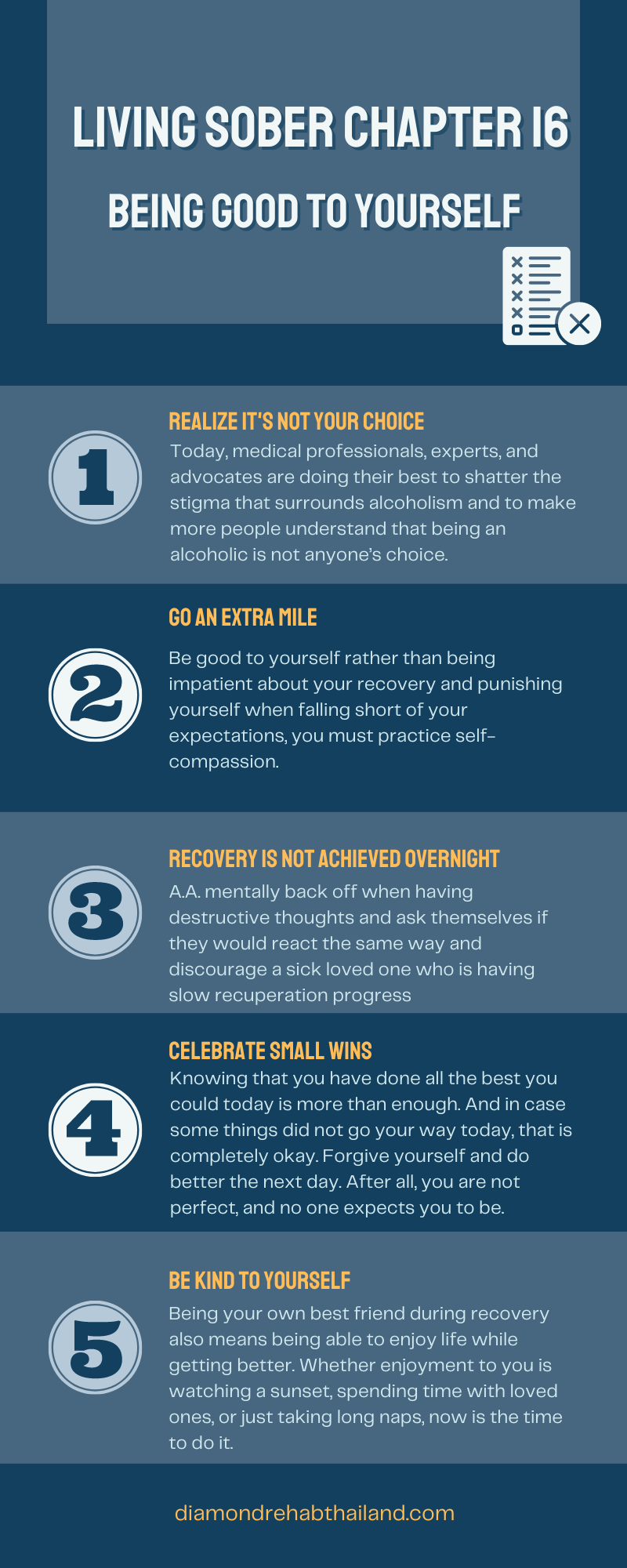
Drinking alcohol might make people momentarily happier, but that does not mean it makes them more satisfied. In fact, it leaves negative emotions to a problem drinker long after the bottle is empty.
When you feel things are going your way, it may be tempting to celebrate with a drink. After all, even with long-term sobriety, it is still possible to think that one drink won’t hurt. And that may be true — but only for the average person. Not for a recovered alcoholic who once convinced themselves that one, two, or a couple of drinks could do no harm and yet ends up with an empty bottle and unpleasant thoughts that are worse than before.
Celebrating in groups may also put pressure on someone to drink just like their peers. But whether alone or with a big crowd, it is important to remind oneself that as little as a sip can be a trigger for alcoholism.
As such, it is crucial to realize that the thought of a drink is natural, but do not let your mind trick you that it is the same as craving for an alcoholic drink. Oftentimes, the thoughts are there to serve as a reminder of the consequences of heavy drinking.
This section of Living Sober PDF leaves problem drinkers and recovered alcoholics alike with the advice that they should never let their guard down against celebratory drinking and instead find ways to celebrate responsibly. More on that in the later chapters.
‘Easy does it’ is a phrase that is often used to advise someone to do something slowly and carefully. Although the saying may apply to many situations in life, it is particularly helpful for recovering alcoholics.
Finding yourself wanting to finish this shorter version of the booklet in one sitting is not so bad. After all, replacing the compulsion to drink with the desire to seek more knowledge about alcoholism is understandable. At times, however, it may be better to maintain a slower pace of life and appreciate the small things.
The slogan “Easy Does It” does the job of reminding A.A. members that their tendency to rush through life and become impatient stops them from pausing and living in the now. And although the frantic pace of modern living subjects people to a hurried pace of life, this kind of pressure may not benefit recovering alcoholics.
After all, recovery is a journey that should be savored with all its ups and downs, simple pleasures, and small gains, instead of agonizing over when to reach the destination.
During recovery, some may find themselves taking on more responsibilities than they could accomplish. Living Sober PDF recommends going through the day at a more spontaneous pace through any of these strategies:
During a hectic day, you might want to stop and take a moment to ask yourself: “Is this hurry really necessary?”
Because oftentimes, you may find that the answer is no.
Arriving at this answer may prove to be useful in kicking the old habit of drinking and being more productive as you channel your energy into purpose. The booklet leaves us with the reminder that no matter how comforting, the saying “Easy Does It” is not meant to encourage procrastination because there are things that are better done today than tomorrow, such as stopping drinking.
But it also would not hurt to stop rushing and start slowing down once in a while, especially if it will allow you to make the most out of your recovery experience.
Ever wonder why you tend to feel low after drinking? That is because as a depressant, alcohol slows down the brain and rewires it to the point of intensifying negative emotions.
This habit of negative thinking is one consequence of active alcoholism that could linger even long after you have stayed sober. And this is a truth that Alcoholics Anonymous understands, as its members have gone through the same path.
However, upon achieving sobriety, thousands of them have now learned to control these negative thoughts and turned them into positive actions. The 19th chapter of Living Sober PDF teaches how developing a grateful attitude can benefit long-term sobriety.
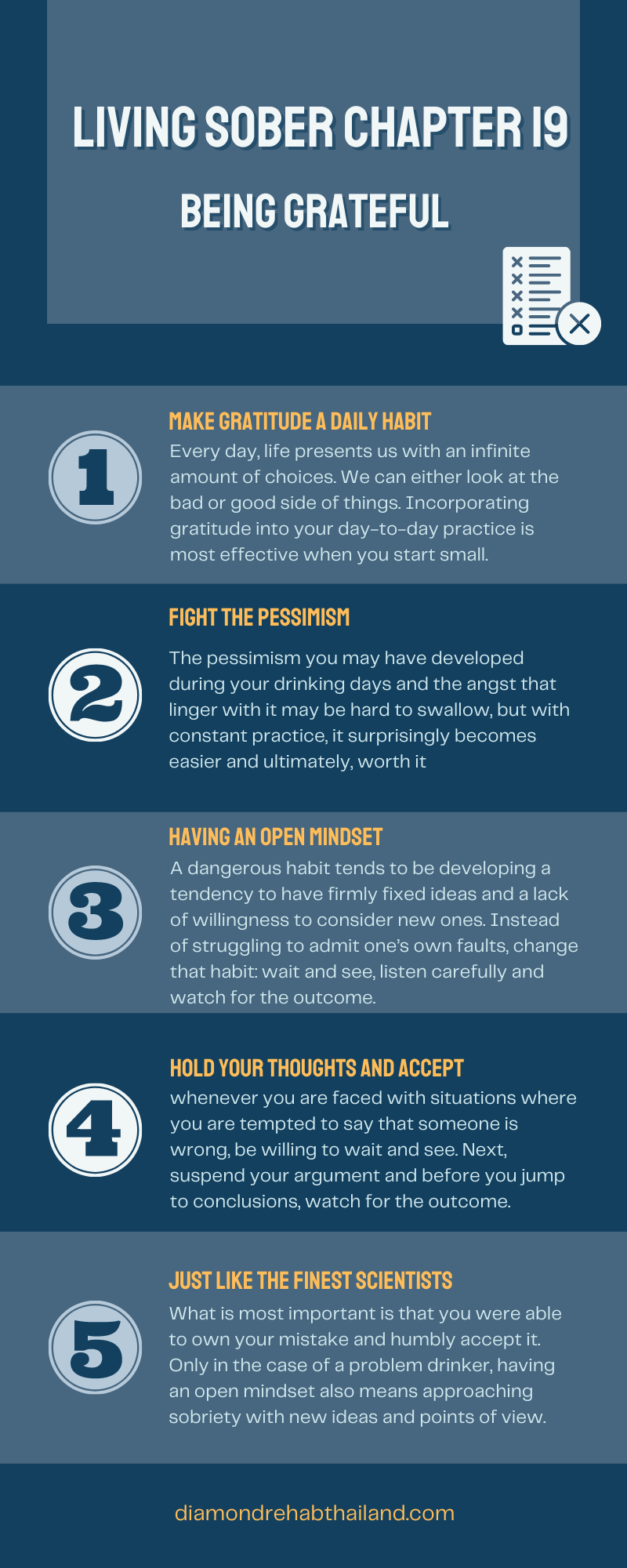
For many recovered alcoholics, this open-mindedness was put to test when they first encountered Alcoholics Anonymous. From rejecting the group entirely, to saying they have recently crossed paths with a drunk A.A. member, and refusing to participate because of the religious stuff — A.A. members are now all familiar with these.
However, listening to these negative opinions and not knowing it yourself are hardly objective. Instead, it is pessimistic and can be described as a refusal of something you typically do not align with. Many A.A. members now realize that instead of giving up because of some ideas they did not agree with, they could have acted differently.
They could have investigated earlier on and actually took a closer look at the group with an open mind. That instead of fretting over differing opinions, they could have been thankful that A.A. is open to casual visitors without obligations and that it has no fees or that it does not demand its members to stick to a doctrine or have a belief.
All these opportunities to make big decisions can be likened to the choices you make to stay sober. You can spend hours convincing yourself why you deserve a drink, or you can also spend the same amount of time to think instead why drinking can endanger your health and perhaps remind yourself of what you went through to find a way out of the dark abyss of alcoholism.
The decision is yours to make. You can either become a master of your life, or a servant to your choices.
There is a difference between the words “drunk” and “drink.”
While the latter may remind you of good times and pleasurable experiences, the former may bring back memories of a mortifying incident you’d rather not talk about.
And although the distinction may be paper thin for some, this chapter of Living Sober PDF reminds us that in sobriety, it is more important to remember your last drunk, not your first drink.
During early days of active drinking, it is normal to associate alcohol with positive emotions. Some may feel more relaxed and even stimulated when the thought of a drink comes.
Others create mental representations of alcohol as they look forward to their next drink. From new clothes to elegant surroundings and a social party, through prolonged alcohol use, the brain easily associates these mental images with drinking.
However, for recovered A.A.’s, these ideas are now misleading. The truth? As they look back, their drinking days never really resulted in those pleasant experiences. Instead, they led to problems that seem to progress the more they drink. What started from a terrible hangover went to discontentment and finally, impaired relationships, job loss, and financial or legal problems.
That said, when someone brings up the idea of a drink today, A.A.’s make an effort to dive deep and try to remember the suffering they went through the last time they were drunk.
That way, they no longer remember drinking as only a few glasses that serve as a social tonic, just like how they did during their first drink. Instead, they now see drinking in a new perspective: one that their last drunk etched into their minds — grief and loss.
For many sober A.A. members, drinking was once a form of self-medication. They drank for the purpose of drowning their sorrows or to feel better.
And along with alcohol, a couple of them also took a wide range of substances to make them feel better. From stimulants used to combat hangovers to prescription painkillers and sedatives that calm anxiety, they have used these substances in the past, too — until they discovered its dangers for people like them.
You see, alcoholics tend to have addictive personalities. Addictive personalities are a set of personality traits that make a person more prone to developing addictions.
And because this tendency can linger root-deep even in those who have been sober for years, A.A.’s try their best to avoid drugs that have a potential for abuse. Examples include marijuana, meth, cocaine, oxycodone, heroin, and ecstasy, among others.
The author clarifies that Alcoholics Anonymous is in no position to be for or against other substances. In fact, the group allows its members to have their own opinions on these matters.
This is similar to their stance on drinking. A.A. does not declare itself as antialcohol, especially considering that there are several people who can enjoy drinking without causing any harm to themselves or to others. However, the avoidance of other medications and herbal supplements is a choice that they made for themselves only, because through their experience, they found that these substances pose a potential threat to them. Drugs tend to reawaken the old craving for “oral magic,” or some form of high. And that’s when it gets dangerous — even using them once or twice may make it easier for others to give in to a drink.
That said, the booklet recommends sharing with your doctor or other healthcare professionals your history of alcoholism and perhaps your desire to avoid certain medications you could develop tolerance from.
It also helps to develop self-awareness on the substances that you take, according to A.A. members. They also listed some substances they steer away from, including:
A’A’s found that being free from these mood-changing substances that could replace alcohol is not difficult at all, if you prioritize your health more than anything.
Over time, the body adjusts to the absence of these drugs and a drug-free way of life is the best option there is for sober A.A.’s. After all, the instant gratification produced by alcohol and other substances are only temporary and never really resolves the underlying issues.
Now that A.A. members are aware of this, they will always choose gradual changes with long-term benefits over instant results any time of the day.
This section of Living Sober PDF starts with a disclaimer that as members, A.A.’s are not qualified to give medical advice on which medications recovered alcoholics should or should not take.
However, what they can offer is their personal experience with these certain medications. And some members found they are better off without them.
Self-pity is a dangerous behavior that leads to alcoholism and can remain in recovered alcoholics even after years of sobriety.
This chapter of Living Sober PDF explains why self-pity is a dangerous state of mind for those in recovery and gives us tips on how to overcome it.

Remaining sober does not always mean you are already free from other problems you may have had during your days of active alcoholism, such as physical or mental health issues.
Since A.A. does not provide medical services, it recognizes and encourages the importance of seeking professional help when staying sober. In fact, its co-founders got help from certain medical experts and clergymen.
After all, reaching out to ask for help only reveals strength and courage, not weaknesses.
There have been many cases of A.A. members who have benefited from the services of professionals, including psychiatrists, nurses, counselors, lawyers, social workers, dentists, or clergymen. The A.A. textbook, Alcoholics Anonymous, specifically encourages members to seek out such help.
And A.A.’s who did reach out for professional help have not found any conflicts between the group’s recommended ideas in keeping alcoholism at bay and medical advice from experts who are well-educated about the disease.
Sober A.A. members are also aware that recovering alcoholics can be some of the most difficult patients to deal with.
Problem drinkers may lie, refuse to follow medication instructions, and may even put the blame on a medical professional when there is poor treatment outcome due to their non-compliance. These self-destructive habits may take a while before they are kicked to the curb. But as recovered alcoholics, they now realize that such behavior defeats the purpose of consulting a professional and could be a warning signal that alcoholism is sneaking up on them once again.
As a newcomer, you may find yourself caught up in conflicting recommendations of A.A.’s on which doctor to consult or which remedy best works for alcoholism. However, it is worth noting that symptoms, medical needs, and situations vary from person to person, therefore what works for others may not always work for you, and vice versa.
Along the way, you may also encounter medical experts who may not agree with the principles of A.A., and that’s totally okay. After all, they may not have experienced active alcoholism and few of them may have actually attended to alcoholic patients. And the same can also be said with A.A. members, who did not have the same level of education in any specific profession as those experts.
Nonetheless, Alcoholics Anonymous supports you in your decision to get better and wishes for you to have the same good fortune they had when they sought help from professionals.
Alcoholism can hurt personal relationships. Either you find yourself searching for a temporary or long-term life partner or you completely dismiss the idea of being emotionally involved with other people.
The 24th chapter of Living Sober PDF reminds us not to rush any decisions that involve emotional connections during the early days of sobriety. A.A. members have witnessed it many times — relapses happening during the state of emotional vulnerability.
The early stages of getting well may give some sense of relief to some and make them feel that they have caught feelings for someone. The warmth and fuzzies involved in this newfound excitement can make the person more susceptible to a drink.
On the other hand, the opposite may also happen. After stopping drinking, one may experience emotional numbness and feel as if they are immune to any kind of affection. As a result, one may turn to drinking once again as a form of self-medication.
These emotional uncertainties may also affect newly recovered alcoholics’ feelings toward those that are closest to them. But before sorting out how one really feels about their spouse, children, parents, or friends, the booklet advises to take a pause and not rush into making decisions that can cause major life changes.
Instead, it acknowledges how your old friends and family may have also been affected by your alcoholism and therefore, they may need some time to recover, too. A.A. specifically recommends Al-Anon Family Groups and Alateen to help nonalcoholic relatives and friends in becoming more educated about alcohol use disorder.
Another caution that recovered alcoholics should observe is not to rely on their partners on making the decision to remain in recovery. While they can be a source of love and encouragement, you should only stay sober for yourself no matter what they did or did not do.
The bottom line? A.A. members want to remind everyone in recovery that feelings can be deceiving and they may change dramatically within just a few months of sobriety.
Therefore, using the principle “First Things First,” you should only focus on your sobriety alone, as it is wiser to wait and see whether your attitude toward someone or something will eventually change and until such time that your sobriety already has a solid foundation that will help you be ready for making reparations in other important aspects of life previously affected by your drinking days.
As former alcoholics, A.A. members were not only full of liquor back in their drinking days. They were also full of ‘ifs.’
As one A.A. put it, they used to be very ‘iffy’ people — continually making excuses that would rationalize their being drunk. For instance, maybe they wouldn’t have gotten drunk if they were treated better by their spouse, if their debts have not piled up, or if human beings just have more humanity in them.
And just like any other habits they have formed during their drinking days, the habit of saying ‘if’ may also stay with them even after years of sobriety.
And Living Sober PDF suggests this is even more dangerous if it happens during recovery.
Some may think it is really good to stay sober, especially if everything goes their way or if nothing goes wrong. But this is where the “iffy” thinking habit completely goes wrong. When one has unconsciously placed conditions on their sobriety, they have to remind themselves that their disease, alcoholism, knows no ifs.
The unchangeable nature of the condition might make someone grab for a drink if a stressful life situation hits them or if they are in a once-in-a-lifetime occasion. Either way, attaching an ‘if’ to your recovery is bound to go downhill. These thoughts of drinking are just lurking in the dark, waiting to pounce at the perfect time — the unconscious “iffy” thinking habit.
But the author of the booklet makes it clear that as recovering alcoholics, they cannot afford those “ifs.” He further reminds that you should not stay sober because of or for the sake of anyone else but yourself.
Entangling your sobriety to people or certain conditions is extremely dangerous, because just like people, life circumstances also quickly change — and former alcoholics, above anyone else, have a complicated relationship with change.

Schedule free assessment
Concerned about yourself or your loved one?
Schedule a free assessment with our experts.